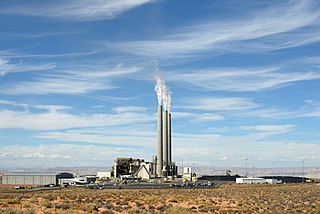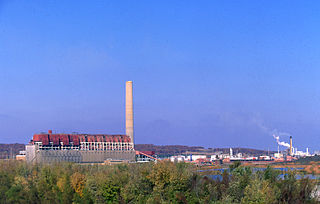
Navajo Generating Station was a 2.25-gigawatt, coal-fired power plant located on the Navajo Nation, near Page, Arizona, United States. This plant provided electrical power to customers in Arizona, Nevada, and California. It also provided the power for pumping Colorado River water for the Central Arizona Project, supplying about 1.5 million acre feet (1.85 km3) of water annually to central and southern Arizona. As of 2017 permission to operate as a conventional coal-fired plant was anticipated until 2017–2019, and to December 22, 2044, if extended. However, in 2017, the utility operators of the power station voted to close the facility when the lease expires in 2019. In March 2019, the Navajo Nation ended efforts to buy the plant and continue running it after the lease expires.

Homer City Generating Station is a decommissioned 2-GW coal-burning power station near Homer City, in Indiana County, Pennsylvania, USA. It is owned by hedge funds and private equity firms and is operated by NRG Energy. Units 1 and 2, rated at 660 MWe, began operation in 1969. Unit 3, rated at 692 MWe nameplate capacity, was launched in 1977. It employed about 124 people.
The Keystone Generating Station is a 1.71-gigawatt, coal power plant located on roughly 1,500 acres (610 ha) in Plumcreek Township, southeastern Armstrong County, Pennsylvania near Crooked Creek, just west of Shelocta, Pennsylvania.

Kyger Creek Power Plant is a 1.08-gigawatt, 1,086 (MW) coal-fired power station located south of Cheshire, Ohio in Gallia County, Ohio. It is operated by the Ohio Valley Electric Corporation (OVEC).

Widows Creek Fossil Plant was a 1.6-gigawatt coal power plant, 4.8 miles (7.7 km) east of Stevenson, Alabama, USA. The plant, operated by the Tennessee Valley Authority, generated about nine billion kilowatt-hours of electricity a year. It had one of the tallest chimneys in the world at 305 metres (1,001 ft), which was built in 1977, and was removed December 3, 2020 in a controlled demolition. Along with the Chimney of the Harllee Branch Power Plant, it is the tallest chimney to be demolished in the United States.

The W. H. Sammis Power Plant was a 2.23-gigawatt coal power plant in Stratton, Jefferson County, Ohio. The plant was operated by Energy Harbor. It began operations in 1960.

Clifty Creek Power Plant is a 1,300-MW coal-fired power station located in Madison, Indiana. Clifty Creek is operated by the Indiana Kentucky Electric Corporation. It is named after Clifty Creek, which enters the Ohio River nearby.

Kingston Fossil Plant, commonly known as Kingston Steam Plant, is a 1.4-gigawatt coal-fired power plant located in Roane County, just outside Kingston, Tennessee, on the shore of Watts Bar Lake. It is operated by the Tennessee Valley Authority. The plant is known for the Kingston Fossil Plant fly ash spill which occurred in December 2008.

Bull Run Fossil Plant, commonly known as Bull Run Steam Plant, is a decommissioned 889 megawatt (MW), coal-fired electric generating station owned and operated by the Tennessee Valley Authority (TVA). The plant is the only coal fired power plant ever constructed by TVA with one unit, and was retired on December 1, 2023.

The A. B. Brown Generating Station is a four-unit, 700 megawatt (MW) power plant, located on the northern bank of Ohio River, 8 miles (10 km) east of Mount Vernon, Indiana and 5 miles (8 km) southwest of Evansville, Indiana just west of the Posey-Vanderburgh County Line. Each of the two coal-fired units has a name-plate capacity of 265.2 MW. Bituminous coal is used as a primary fuel type, which can be substituted for natural gas. There are also two gas turbine units, 88.2 MW of nameplate capacity each. The facility is owned by Centerpoint Energy. Vectren announced a plan to retire the plant in 2023 and replace it with a natural gas power plant; however, this plan needs to be approved by the Indiana Utility Regulatory Commission.
The Harding Street Station is a 12-unit, 1,196 MW nameplate capacity, gas-, coal, and oil-fired generating station located at 3700 S. Harding St., in Indianapolis, Indiana, U.S. It is owned by AES Indiana, a subsidiary of AES. Completed in 1973, Harding Street Station's tallest chimneys are 565 feet (172 m) in height.

The Shawnee Fossil Plant is a coal-fired power plant owned and operated by the Tennessee Valley Authority, located near Paducah, Kentucky. The closest city is Metropolis, Illinois, across the Ohio River to the northeast. The Shawnee Fossil Plant was created with the intentions of providing sufficient electricity to the national defense industry escalating demand for power which could not be met with the Commonwealth of Kentucky's then-current infrastructure. The plant also provided economic growth to the area in the post-WWII era creating jobs and a stronger infrastructure to support future state developments.

The Paradise Combined Cycle Plant is a natural gas power plant operated by the Tennessee Valley Authority (TVA). Located just east of Drakesboro, Kentucky, it was the highest power capacity power plant in Kentucky. The plant currently has a capacity of 1.02-gigawatts. The plant originally consisted of three coal units, with a combined capacity of 2,632 MW. Units 1 and 2 were retired in 2017, and replaced with the natural gas units, and Unit 3 was retired in 2020.

The Johnsonville Fossil Plant was a 1.5-gigawatt, coal power plant located in New Johnsonville, Humphreys County, Tennessee, United States. The plant generated electricity from 1951 to 2017. It was operated by the Tennessee Valley Authority (TVA).
The Allen Combined Cycle Plant is a 1.1-gigawatt natural gas power plant located south of Memphis, Tennessee that began generating electricity in 2018. It is operated by Tennessee Valley Authority (TVA).

The Allen Fossil Plant was a 741-megawatt (MW), coal power plant located south of Memphis, Tennessee. It generated electricity from 1959 to 2018. At the time of its closure, the plant was operated by Tennessee Valley Authority (TVA).

The Gallatin Fossil Plant is a coal and natural gas-fired power plant near Gallatin, Tennessee operated by the Tennessee Valley Authority (TVA). The plant was originally entirely a coal-fired plant, constructed in the 1950s, and natural gas units were added later.

Watts Bar Steam Plant was a 267-megawatt (MW), coal power plant operated by the Tennessee Valley Authority (TVA) located in Rhea County, Tennessee near the present site of Watts Bar Nuclear Plant and Watts Bar Dam. The plant was the first coal-fired power plant constructed by TVA.
















